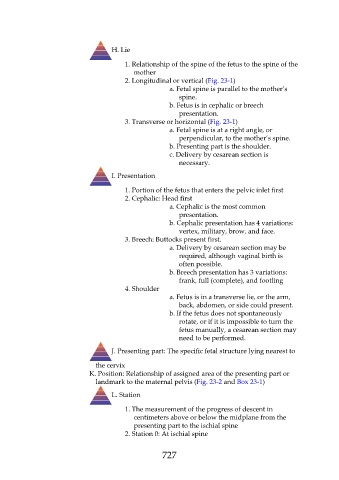Page 727 - Saunders Comprehensive Review For NCLEX-RN
P. 727
H. Lie
1. Relationship of the spine of the fetus to the spine of the
mother
2. Longitudinal or vertical (Fig. 23-1)
a. Fetal spine is parallel to the mother’s
spine.
b. Fetus is in cephalic or breech
presentation.
3. Transverse or horizontal (Fig. 23-1)
a. Fetal spine is at a right angle, or
perpendicular, to the mother’s spine.
b. Presenting part is the shoulder.
c. Delivery by cesarean section is
necessary.
I. Presentation
1. Portion of the fetus that enters the pelvic inlet first
2. Cephalic: Head first
a. Cephalic is the most common
presentation.
b. Cephalic presentation has 4 variations:
vertex, military, brow, and face.
3. Breech: Buttocks present first.
a. Delivery by cesarean section may be
required, although vaginal birth is
often possible.
b. Breech presentation has 3 variations:
frank, full (complete), and footling
4. Shoulder
a. Fetus is in a transverse lie, or the arm,
back, abdomen, or side could present.
b. If the fetus does not spontaneously
rotate, or if it is impossible to turn the
fetus manually, a cesarean section may
need to be performed.
J. Presenting part: The specific fetal structure lying nearest to
the cervix
K. Position: Relationship of assigned area of the presenting part or
landmark to the maternal pelvis (Fig. 23-2 and Box 23-1)
L. Station
1. The measurement of the progress of descent in
centimeters above or below the midplane from the
presenting part to the ischial spine
2. Station 0: At ischial spine
727

